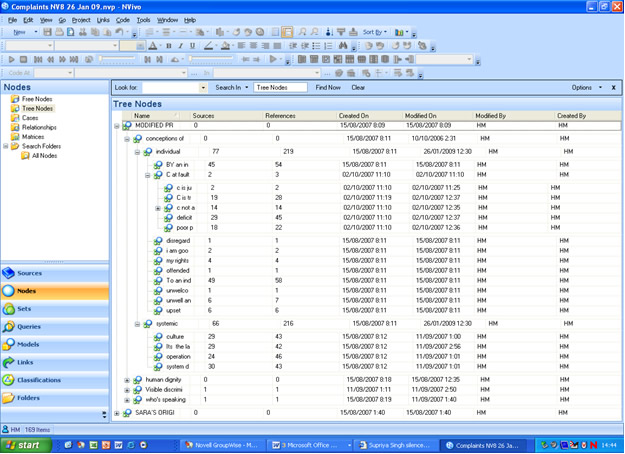|
Title: Second Thoughts: The Uses of Software as Your Research Question Changes. The Harassment Complaints Project.
Author: Helen Marshall
Analysis processes
As outlined in 'Working with Data', an important distinction in the early analysis was between conceptions of discrimination as caused by an individual and those who saw discrimination as 'systemic'. The coding reports showed that we had 23 documents where there was coding for 'individual' conception but not for 'systemic', 8 with coding only for 'systemic', 15 with coding for neither and 40 with coding for both. Generating the reports kept crashing the project until we re-set the project size in the software to large.
We decided to run a matrix looking at the conceptions of discrimination by who's speaking. This is when I created the new tree using auto coding and merging described in 'Working with Data') The fun began when we looked at the numbers and the words behind them in the matrix.
My note in the research diary (reproduced partially below complete with spelling errors) shows how answering one question raises another. It also reflects one the difficulties we encountered.
9/07/2007 1:40 PM
OK here's what the results are saying to me (conceptions and who's speaking matrix results):
Complainants made more comments suggesting and individual perception than respondents. (60 comments from complainants vs. 19 from respondents). The commission seemed as likely o see systemic as individual (38 systemic comments 37 individual). Respondents seemed more likely to make comments indicating a systemic view (28 systemic, 19 individual). I was surprised that the split between perceptions is so equal. There are 224 comments in the perceptions node. 116 are coded in the individual child node and 108 in the systemic child node. So it's not the case that people can't see systemic discrimination.
But maybe people in particular positions or with particular complaints see things differently? So a matrix for perceptions by type of discrimination first (because size will need to be recoded and I've left the grey bible* at work!).
Here, (conceptions by discrimtype) sexual harassment is obviously seen as individual (33 out of 57 comments are coded individual) work and family as systemic (13 out of 25 comments coded as individual) and sex discrimination in the middle (17 out of 37 comments coded as individual).
Does complainant gender make a difference? Not enormously but a bit? A slightly higher proportion of women make comments indicating an individual conception (about 55% compared to about 45% on a rough calculation) but the majority of complainants are women. This makes sense if we remember that women are much more likely to complain of sexual harassment (5/6 s.h complaints have a female complainant). While there are cases in the files of harassment by multiple respondents, sexual harassment fits an 'individual' conception. (See discrim type by case for exact figures) On the other hand, work/family discrimination seems to me to fit a 'systemic' conception - it's about the policies and practices not about a nasty individual action. About 3/4 w/f complainants are female. So maybe we'd expect a slightly higher proportion of systemic comments to come from female complainants? SARA IT MIGHT BE WORTH EXPLORING THIS A BIT MORE?
|
*The 'Grey Bible' is Bazeley 2007. It replaced the 'yellow bible' (Bazeley and Richards 2000)
What did our numbers mean?
The unit of analysis in the complaints project is the individual complaint. So the numbers in the matrices and the words in the cells behind the numbers do not represent the number of people with a particular conception. They are the numbers of comments coded both as being from a particular voice and reflecting a particular conception. We had to avoid believing that 'the respondent in case 35 has an individual conception'. As this particular penny dropped, we began ask more questions of our data - were there varieties of understanding within 'structural' and individual and did they relate to characteristics like whether outside lawyers became involved in the complaint? We also became interested in how the conceptions of the complainants and respondents seemed to be very similar. Our matrix for 'conceptions by who's speaking' showed almost identical numbers of comments showing a 'structural' conception from complainants (19) and respondents (47)
My lumpy coding could now be supplemented by coding on from the two nodes under conceptions and by merging in some of Sara's original fine -grained nodes. You can see an image of the tree structure that emerged in the 'modified project' below, showing how the simple lumpy coding that led to the queries then became a much more complex coding structure. For those who want to see the details more clearly and here is a link here to the node report. We also began to see the importance of 'human dignity' to complainants, and did some more coding for this. Eventually we had 128 references from 59 sources to variations of this concept.

So finally we began to understand that the conception that discrimination is sometimes the unfortunate result of structuring business as usual is embedded in the handling of complaints. Complainants, respondents and the commission are all working within a framework where immediate demands of 'the business case' are accepted as more powerful than longer term considerations like retaining staff goodwill, or abstract concerns for fairness. The complainants are more likely than respondents to make reference to considerations of human dignity - where respondents speak of this issue it is most often in terms of regretting if the complainant feels upset- but it is as though everyone partially accepts that business do unfair things in the name of business.
The way in which the business case trumps fairness and the importance of human dignity were the main messages Sara gave in reporting the NVivo project.
Back to Project Home Page
|